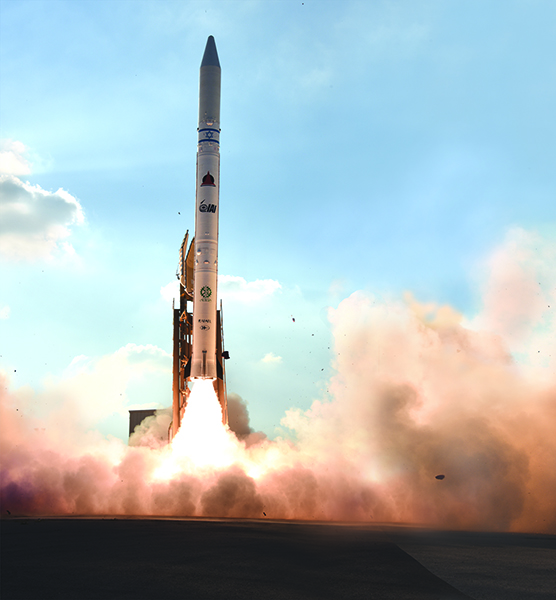What Lies Ahead for the IAF Missile Test Unit?
The Missile Test Unit in the Israeli Air Force is in charge of testing all of the IDF's aerial defense systems and launching Israeli satellites into space. As part of the IDF's Gideon multi-year plan, the unit is currently undergoing an outsourcing process that will last throughout 2017
IsraelDefense
| 26/02/2017
The Missile Test Unit (MTU) operates from Palmahim AFB and performs a large variety of missions such as planning and performing development tests for aerial defense systems, supporting development processes of weapons and launching satellites. The unit’s latest and most prominent actions include launching the “Ofek 11” satellite and the “David’s Sling” system test. As part of the “Gideon” multi-year plan, the unit is currently undergoing an outsourcing process that will last throughout 2017.
Differently to other units, it was decided that the MTU would remain a military unit and that personnel from Rafael Advanced Defense Systems would be integrated into it. “A significant part of the unit’s missions will be performed by ‘Rafael’ personnel, but the unit will remain under its current military command," emphasized Lt. Col. Ophir, Commander of the MTU.
Safety Above All
“We perform energy rich tests with missiles and launch satellites to space from the heart of central Israel thanks to the high professional level and devotion the unit’s personnel display," said Lt. Col. Ophir. How do they do it, what are the unit’s guiding principles and how do they keep civilians safe while successfully performing their mission?
Security is the most important matter when planning a test. There are about two million civilians and many national infrastructures in the base’s 10-15 km radius, so safety is always a first priority.
In cooperation with each test’s security engineer, the unit’s security department creates a “security sleeve” in accordance with the missile’s capabilities and malfunction potential, in other words, they sketch a flight path which will not endanger civilians. In case of a deviation from said “sleeve," the security officer will destroy the missile and its debris will also fall inside the sleeve. The unit’s personnel define risk zones and is necessary close roads in cooperation with the police, block access to parts of the sea in cooperation with the navy and cooperate with the Ben-Gurion Airport in reference to airspace security.
“The security officer has his consideration. In the case that a missile performs a sharp maneuver with a clear deviation trend from the safety sleeve, it will be destroyed immediately, but if it performs a gentle turn, I won’t be quick to pull the trigger because I have more time to make my decision. The dilemma: on one hand to adhere to the safety procedures and on the other hand the understanding that the success of these tests and launches is critical. There is one chance to succeed and it’s a heavy responsibility," explained Col. (res.) Yaakov who knows what he’s talking about: in one of the first “Arrow” missile tests, he pressed the famous "Red Button" when the missile in the air stopped streaming data. The missile was destroyed.

Time to Launch
In large tests such as interception tests, many aircraft participate in the complex procedure. In cooperation with the IAF’s Flight Test Squadron, a fighter aircraft takes off escorted by another aircraft because it crosses the Israeli border in order to launch the target missile. Additional aircraft take off in order to document the test while emphasizing the launch of the target missile, the intercepting missiles flight path and other aircraft, such as transport and refueling aircraft assist other missions.
The test manager sits facing the hall and is in continuous communication with many elements. “The manager is the one who gives the OK after receiving approval from all of the elements – the ATC department approves that the forces are in position and that the coast is clear, the technical manager approves that the field systems are usable and the industries personnel approve that the weapon is ready for the test. We won’t begin the test if I’m not certain that we meet the minimal conditions," shared Maj. Eyal, Commander of the Test Managers Department. When the final approval is given and the missile is launched, the security officer begins supervising the test. If nothing unusual happens, you can hear shouts of joy and know that the mission was successful.
Success or Failure
In November, the MTU launched the advanced “Ofek 11” satellite, which was manufactured by Israel Aerospace Industries (IAI). “We were told about the launch two years before hand and began preparing accordingly," recalled Lt. Col. Ophir.
The satellite launcher arrived at the base a few weeks in advance and they immediately began preparing it for the launch and making sure that it “communicates” properly with the test field’s systems. Two weeks later the “Ofek 11” satellite arrived and was stored in a unique storage space. “A few days before the launch, Israeli defense industries connected the satellite to the launcher. It is a complex and delicate process," said Lt. Col. Ophir. “All of the defense industries work together in order to allow Israel to hold this unique capability."

This article was originally published on the IAF website
The Missile Test Unit in the Israeli Air Force is in charge of testing all of the IDF's aerial defense systems and launching Israeli satellites into space. As part of the IDF's Gideon multi-year plan, the unit is currently undergoing an outsourcing process that will last throughout 2017
The Missile Test Unit (MTU) operates from Palmahim AFB and performs a large variety of missions such as planning and performing development tests for aerial defense systems, supporting development processes of weapons and launching satellites. The unit’s latest and most prominent actions include launching the “Ofek 11” satellite and the “David’s Sling” system test. As part of the “Gideon” multi-year plan, the unit is currently undergoing an outsourcing process that will last throughout 2017.
Differently to other units, it was decided that the MTU would remain a military unit and that personnel from Rafael Advanced Defense Systems would be integrated into it. “A significant part of the unit’s missions will be performed by ‘Rafael’ personnel, but the unit will remain under its current military command," emphasized Lt. Col. Ophir, Commander of the MTU.
Safety Above All
“We perform energy rich tests with missiles and launch satellites to space from the heart of central Israel thanks to the high professional level and devotion the unit’s personnel display," said Lt. Col. Ophir. How do they do it, what are the unit’s guiding principles and how do they keep civilians safe while successfully performing their mission?
Security is the most important matter when planning a test. There are about two million civilians and many national infrastructures in the base’s 10-15 km radius, so safety is always a first priority.
In cooperation with each test’s security engineer, the unit’s security department creates a “security sleeve” in accordance with the missile’s capabilities and malfunction potential, in other words, they sketch a flight path which will not endanger civilians. In case of a deviation from said “sleeve," the security officer will destroy the missile and its debris will also fall inside the sleeve. The unit’s personnel define risk zones and is necessary close roads in cooperation with the police, block access to parts of the sea in cooperation with the navy and cooperate with the Ben-Gurion Airport in reference to airspace security.
“The security officer has his consideration. In the case that a missile performs a sharp maneuver with a clear deviation trend from the safety sleeve, it will be destroyed immediately, but if it performs a gentle turn, I won’t be quick to pull the trigger because I have more time to make my decision. The dilemma: on one hand to adhere to the safety procedures and on the other hand the understanding that the success of these tests and launches is critical. There is one chance to succeed and it’s a heavy responsibility," explained Col. (res.) Yaakov who knows what he’s talking about: in one of the first “Arrow” missile tests, he pressed the famous "Red Button" when the missile in the air stopped streaming data. The missile was destroyed.

Time to Launch
In large tests such as interception tests, many aircraft participate in the complex procedure. In cooperation with the IAF’s Flight Test Squadron, a fighter aircraft takes off escorted by another aircraft because it crosses the Israeli border in order to launch the target missile. Additional aircraft take off in order to document the test while emphasizing the launch of the target missile, the intercepting missiles flight path and other aircraft, such as transport and refueling aircraft assist other missions.
The test manager sits facing the hall and is in continuous communication with many elements. “The manager is the one who gives the OK after receiving approval from all of the elements – the ATC department approves that the forces are in position and that the coast is clear, the technical manager approves that the field systems are usable and the industries personnel approve that the weapon is ready for the test. We won’t begin the test if I’m not certain that we meet the minimal conditions," shared Maj. Eyal, Commander of the Test Managers Department. When the final approval is given and the missile is launched, the security officer begins supervising the test. If nothing unusual happens, you can hear shouts of joy and know that the mission was successful.
Success or Failure
In November, the MTU launched the advanced “Ofek 11” satellite, which was manufactured by Israel Aerospace Industries (IAI). “We were told about the launch two years before hand and began preparing accordingly," recalled Lt. Col. Ophir.
The satellite launcher arrived at the base a few weeks in advance and they immediately began preparing it for the launch and making sure that it “communicates” properly with the test field’s systems. Two weeks later the “Ofek 11” satellite arrived and was stored in a unique storage space. “A few days before the launch, Israeli defense industries connected the satellite to the launcher. It is a complex and delicate process," said Lt. Col. Ophir. “All of the defense industries work together in order to allow Israel to hold this unique capability."

This article was originally published on the IAF website



